
Water | Resources
Sperm counts in men from industrialized countries have dropped by more than 50 percent in less than 40 years

Could exposure to chemicals be impairing our ability reproduce as a species
Researchers from a study done at Hebrew University-Hadassah Braun School of Public Health and Community Medicine in Jerusalem announced last week that sperm counts in men from America, Europe, Australia and New Zealand showed a 52.4 percent decline in sperm concentration and a 59.3 percent decline in total sperm count among North American, European, Australian and New Zealand men. And the rate of decline is not slowing.
This analysis did not look into reasons for the decline, but noted that falling sperm counts have previously been linked to various factors such as exposure to certain chemicals and pesticides, smoking, stress and obesity.
No significant decline was seen in South America, Asia and Africa, but researchers noted that far fewer studies have been done in these regions.
REUTERS: Sperm Count Dropping in Western World
THE NEW YORK TIMES: Sperm Count in Western Men Has Dropped Over 50 Percent Since 1973, Paper Finds
Toxic Free Watch Strap?
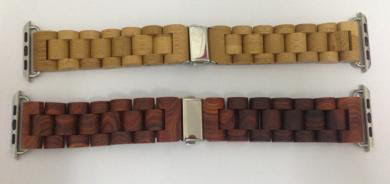
Wooden Watch Strap
Question from Jonathan
Hi Debra,
I’ve just discovered your page. It is WONDERFUL. My wife and I are attempting to slowly but surely reduce our toxic levels at home (particularly plastics!) for ourselves and our children, and your site is going to help us a lot for sure!
My latest mission is watch straps! I’ve come to realise that it is not so easy to find something toxin free! And if a watch wearer, we are in contact with the strap ALL day!
I guess that’s where the problem originates! They are on all day, so have to resist wear and tear, sweat and other liquids, sun and heat. So they mostly are build tough, and that means:
Plastic straps: are… plastic. And the non-solid “woven fabric” straps like NATO straps are often either nylon or Cordura based or some other plastic.
Leather. But leather straps will all surely be chromium based leather. Rawhide wouldn’t be flexible enough etc. And leather is just awful in so many ways. Btw you may have already seen it but here’s a great post on leather: How Leather Is Slowly Killing the People and Places That Make It
So I searched for “vegan leather” straps. These seem to be pure plastic or PU coated leather. Sigh…
Then I heard about cork watch straps! Made from real cork! I don’t know much about cork. But I don’t trust that cork could withstand much movement or wear, could it? So I would bet the cork is bound with melamine or PU or something to stop it falling apart. Particularly cus watch straps are so thin! Also, I have no idea about the ethics or processes of cork manufacturing.
Any thoughts? Could this be the answer?
What about canvas? What is canvas? I see some canvas straps that are backed with leather anyhow. But a pure canvas strap? Is that possible? I’m thinking about canvas like what paintings are on. They’re not plastic these days surely? Linen or something?
Any other ideas? The more I look, the less hope I find! Product listings are SO vague and retailers and manufacturers alike! I need help Debra! Help!
Debra’s Answer
I stopped wearing a watch many years ago for all the reasons you state.
But I still needed to know what time it was.
There are watches you can carry without a strap, such as watches on necklaces, pocket watches, travel clocks you can put in a pocket or purse and probably more I’m not aware of.
Today the time is on your cell phone (if you carry one) so there’s not much need for a watch.
You didn’t mention metal watch bands, but they often cause rashes.
Readers, any success with finding a nontoxic watch band?
The Short List of Rules for Choosing Products

I can’t tell you who wrote this because the person who sent it to me didn’t know, but I felt it was worth passing along.
Inspired by Michael Pollan’s Food Rules, here is a short list of guidelines for choosing products—any product.
I couldn’t have said it better myself.
ELEVEN RULES FOR CHOOSING PRODUCTS
- If it is cheap, it probably has hidden costs.
- If it starts as a toxic input (like ethylene glycol in the manufacture of polyester), you probably don’t want it in your house or office.
- Use materials made from substances you can imagine in their raw or natural state.
- Use carbohydrate-based materials (i.e., natural fibers) when you can.
- Just because almost anything can kill you doesn’t mean fabrics should.
- Pay more, use less.
- Consult your nose – if it stinks, don’t use it.
- If they can’t tell you what’s in it, you probably don’t want to live with it. (Note: this is not just the fibers used to weave the fabric – did the processing use specific chemicals, like heavy metals in the dyestuff, or are there any finishes on the fabric?)
- Avoid materials that are pretending to be something they are not (like polyester mimicking linen).
- Question materials that make health claims.
- Regard space-age materials with skepticism.
The Clean Bedroom
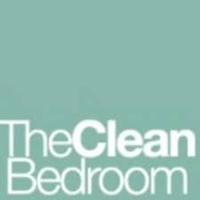 Everything you need to create a toxic-free bedroom all in one place. Organic mattresses and bedding, organic crib mattresses and nursery bedding, and bedroom furniture–nontoxic, chemical-free and hypoallergenic. They provide personalized service to fit the health and comfort needs of each customer. Articles and blog posts provide helpful information for allergy sufferers and patients with multiple chemical sensitivities, and product comparisons assist customers in making the right purchase decisions.
Everything you need to create a toxic-free bedroom all in one place. Organic mattresses and bedding, organic crib mattresses and nursery bedding, and bedroom furniture–nontoxic, chemical-free and hypoallergenic. They provide personalized service to fit the health and comfort needs of each customer. Articles and blog posts provide helpful information for allergy sufferers and patients with multiple chemical sensitivities, and product comparisons assist customers in making the right purchase decisions.
Marketplace: Handwork of India
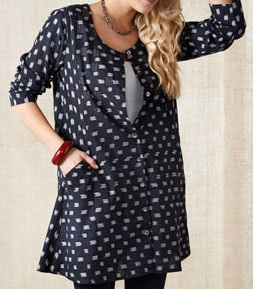 Really beautiful, colorful clothing made of cotton and other natural fibers in India. All women’s sizes, including plus sizes. “MarketPlace: Handwork of India is a pioneering nonprofit that empowers women in India to break the cycle of poverty, as they become leaders in their work, their homes, and their neighborhoods, and effect lasting change in their communities. In MarketPlace’s comprehensive and creative organization, economic development is only the first step for these brave and resourceful women. We work with over 400 artisans who are organized into 11 independent co-operatives that produce high-quality women’s apparel and home decor. They learn skills such as sewing and embroidery, and participate in all aspects of running the cooperatives. In addition, programs offer educational and enrichment opportunities designed to help the artisans overcome personal, cultural and financial obstacles. ”
Really beautiful, colorful clothing made of cotton and other natural fibers in India. All women’s sizes, including plus sizes. “MarketPlace: Handwork of India is a pioneering nonprofit that empowers women in India to break the cycle of poverty, as they become leaders in their work, their homes, and their neighborhoods, and effect lasting change in their communities. In MarketPlace’s comprehensive and creative organization, economic development is only the first step for these brave and resourceful women. We work with over 400 artisans who are organized into 11 independent co-operatives that produce high-quality women’s apparel and home decor. They learn skills such as sewing and embroidery, and participate in all aspects of running the cooperatives. In addition, programs offer educational and enrichment opportunities designed to help the artisans overcome personal, cultural and financial obstacles. ”
On the Plus Side
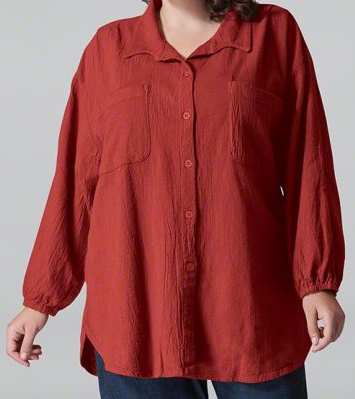 An entire site dedicated to plus sizes for women 1x-8x. “For over 30 years, On The Plus Side has been perfecting the fit and style of our plus size clothing for women. Over 90% of our clothing is made from natural fiber and designed to celebrate your curves.” You’ll need to check fabric content carefully, but I wanted to include this for the plus sizes, which can be difficult to find in natural fibers. While you have to sift through the blends, this Long Sleeve Oversize Shirt in the photo, for example, is 100% cotton and comes in 30 colors sizes 1x-8x. And it’s hand-dyed with eco-friendly dyes. So consider this site to be a treasure hunt.
An entire site dedicated to plus sizes for women 1x-8x. “For over 30 years, On The Plus Side has been perfecting the fit and style of our plus size clothing for women. Over 90% of our clothing is made from natural fiber and designed to celebrate your curves.” You’ll need to check fabric content carefully, but I wanted to include this for the plus sizes, which can be difficult to find in natural fibers. While you have to sift through the blends, this Long Sleeve Oversize Shirt in the photo, for example, is 100% cotton and comes in 30 colors sizes 1x-8x. And it’s hand-dyed with eco-friendly dyes. So consider this site to be a treasure hunt.
Hackwith Design House
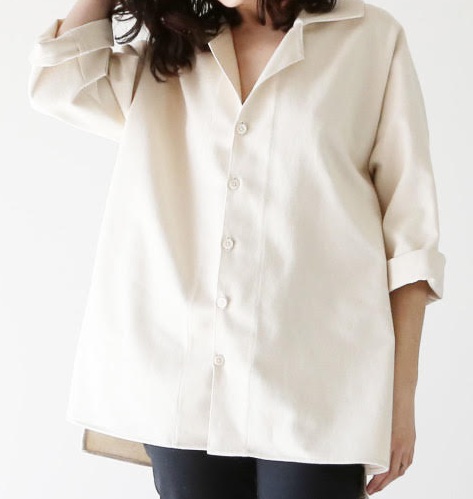 “Simple, beautiful clothing made in America.” All women’s sizes (choose HDH Plus from the Shop menu for plus sizes). Descriptions do not tell fabrics, but here’s why: “We source most of our fabrics from a local, family-owned fabric store that specializes in run-off and second-hand fabrics in order to cut down on waste while also supporting our local economy. As a result, we cannot always know the exact fiber content of the fabrics we buy. We strive to provide our customers with quality fabrics that are sourced in a responsible and environmentally-friendly manner. I can tell you however that any of our pieces listed on our website as being made of Cotton Slub, Cotton Gauze, Cotton Denim, or Hemp Silk and Organic Cotton are 100% natural fibers.” If you’re curious about any one particular piece, feel free to contact them and ask about fiber content.
“Simple, beautiful clothing made in America.” All women’s sizes (choose HDH Plus from the Shop menu for plus sizes). Descriptions do not tell fabrics, but here’s why: “We source most of our fabrics from a local, family-owned fabric store that specializes in run-off and second-hand fabrics in order to cut down on waste while also supporting our local economy. As a result, we cannot always know the exact fiber content of the fabrics we buy. We strive to provide our customers with quality fabrics that are sourced in a responsible and environmentally-friendly manner. I can tell you however that any of our pieces listed on our website as being made of Cotton Slub, Cotton Gauze, Cotton Denim, or Hemp Silk and Organic Cotton are 100% natural fibers.” If you’re curious about any one particular piece, feel free to contact them and ask about fiber content.
Tampon Tribe
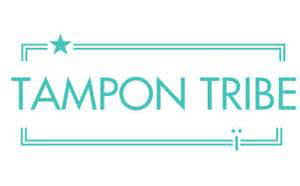 An affordable monthly subscription service for organic tampons, pads, and pantyliners. Toxin-free, plastic-free, chemical-free. Made from 100% certified organic cotton that is strictly monitored and regulated in all stages of production (GOTS: Global Organic Textile Standard, ICEA: European Eco/Bio Standard). Chlorine bleach and dioxin-free. There are no glues, synthetics, perfumes, bleaches or dyes used. Customize your box to get the right mix of pads, tampons, and pantyliners for your body.
An affordable monthly subscription service for organic tampons, pads, and pantyliners. Toxin-free, plastic-free, chemical-free. Made from 100% certified organic cotton that is strictly monitored and regulated in all stages of production (GOTS: Global Organic Textile Standard, ICEA: European Eco/Bio Standard). Chlorine bleach and dioxin-free. There are no glues, synthetics, perfumes, bleaches or dyes used. Customize your box to get the right mix of pads, tampons, and pantyliners for your body.
Bedworks of Maine
 Beds, bedroom, and convertible futon sofa frames made in Maine. “Classic lines, solid construction and gorgeous finishes are the hallmarks of the furniture we make at The BedWorks of Maine. All of our bedroom pieces and bed frames, both traditional and platform bed, as well as our futon frames are crafted out of North American ash, a sustainable and renewable hardwood.” Can be ordered unfinished.
Beds, bedroom, and convertible futon sofa frames made in Maine. “Classic lines, solid construction and gorgeous finishes are the hallmarks of the furniture we make at The BedWorks of Maine. All of our bedroom pieces and bed frames, both traditional and platform bed, as well as our futon frames are crafted out of North American ash, a sustainable and renewable hardwood.” Can be ordered unfinished.
Havelock Wool
 “Farm to walls” building insulation made from sheep’s wool. Made of 100% wool (with a small amount of natural boric acid added as an insect repellant). Their wool is sourced in New Zealand where sheep roam pastoral lands and eat grass in serene settings. It is blended and washed there before being shipped to their manufacturing facility in Nevada where they make both loose-fill and batt form insulation.
“Farm to walls” building insulation made from sheep’s wool. Made of 100% wool (with a small amount of natural boric acid added as an insect repellant). Their wool is sourced in New Zealand where sheep roam pastoral lands and eat grass in serene settings. It is blended and washed there before being shipped to their manufacturing facility in Nevada where they make both loose-fill and batt form insulation.






